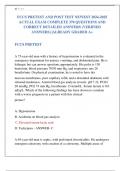Exam (elaborations)
FCCS PRETEST AND POST TEST NEWEST ACTUAL EXAM COMPLETE 370 QUESTIONS AND CORRECT DETAILED ANSWERS (VERIFIED ANSWERS) |ALREADY GRADED A+
- Course
- Institution
FCCS PRETEST AND POST TEST NEWEST ACTUAL EXAM COMPLETE 370 QUESTIONS AND CORRECT DETAILED ANSWERS (VERIFIED ANSWERS) |ALREADY GRADED A+
[Show more]



